
REPRINTS

The first piece of apparatus assigned to each of the South Manchester fire companies after the organization
of the department was an 1898 hand-drawn hose cart which was to be pulled to a fire by the firemen or drawn
behind a horse-drawn wagon by a person sitting on the rear of the wagon. In 1899 Company No. 1 purchased a
hand-drawn ladder truck to be used on the west side of town. It was initially stored at Charles S. Cheney's
barn on Hartford Road.
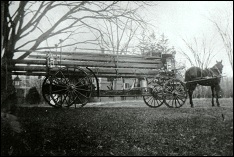 In July, 1901 an apparatus was added to the truck allowing it to be pulled by a horse
rather than being drawn by hand. Shortly after, on December 13, 1901, a public notice appeared in the newspaper.
Apparently, there was a delay in getting to a fire with the ladder truck. Citizens were getting into the habit
of jumping on the truck as it passed and riding it to the fire. The load was too great for the horse and had
"seriously handicapped" the response. The notice stated that only members of the fire companies would be
allowed to ride the apparatus, and they too would have restrictions.
In July, 1901 an apparatus was added to the truck allowing it to be pulled by a horse
rather than being drawn by hand. Shortly after, on December 13, 1901, a public notice appeared in the newspaper.
Apparently, there was a delay in getting to a fire with the ladder truck. Citizens were getting into the habit
of jumping on the truck as it passed and riding it to the fire. The load was too great for the horse and had
"seriously handicapped" the response. The notice stated that only members of the fire companies would be
allowed to ride the apparatus, and they too would have restrictions.
A ladder truck for the east side of town was purchased for Company No. 4 in 1900 which was not as heavy or
as expensive a piece as Company No. 1's. The west side truck was more adapted to city use, where horses were
available to pull the truck and where paved streets were available on which to run. The new truck for Company
No. 4 was intended to be pulled by hand, or towed behind a horse-drawn wagon if one was available.
At a regular meeting of Company No. 1 on February 14, 1900, a committee consisting of David Woodhouse,
William Miller and William Dalton was appointed to see how much money could be raised toward the purchase of a
horse-drawn hose wagon for the company to replace the hose cart. A month later they reported they had raised
$52.00. At a meeting on June 13, the company voted to appropriate $250.00 as partial payment for a new hose
wagon to be purchased from the James Pullar & Co. of Hartford for $310. It weighed 1,300 pounds and was finished
in bright red with gold trim. The bed of the wagon was approximately four feet by eight feet and carried 800
feet of hose. It is unknown where the Company stored this piece of equipment when it was first delivered, but
Cheney Brothers had already begun work on a new fire station for Company No. 1.
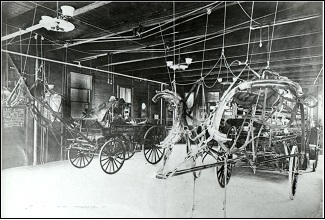
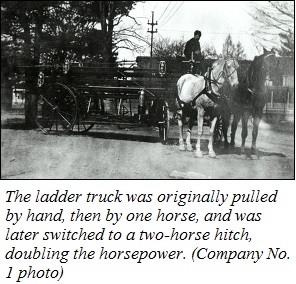 The new station on Pine Street was dedicated in 1901. The apparatus floor was thirty feet by forty-eight
feet with four horse stalls in the rear portion. There were sets of harnesses suspended from the ceiling in
front of the fire apparatus. When a fire alarm was sent in, the following results were produced automatically:
The number of the box was displayed on an indicator, the lights in the hose house were turned on, the horses
were unhitched from their fastenings and the doors to their stalls sprung open. All this was done without the
aid of any personnel! The horses ran to their positions where the firemen had only to fasten two or three
clasps on the harnesses. Then the driver pulled a cord over his seat which released the spring loaded front
doors and the apparatus was then ready to go to a fire!
The new station on Pine Street was dedicated in 1901. The apparatus floor was thirty feet by forty-eight
feet with four horse stalls in the rear portion. There were sets of harnesses suspended from the ceiling in
front of the fire apparatus. When a fire alarm was sent in, the following results were produced automatically:
The number of the box was displayed on an indicator, the lights in the hose house were turned on, the horses
were unhitched from their fastenings and the doors to their stalls sprung open. All this was done without the
aid of any personnel! The horses ran to their positions where the firemen had only to fasten two or three
clasps on the harnesses. Then the driver pulled a cord over his seat which released the spring loaded front
doors and the apparatus was then ready to go to a fire!
The following article is from a December 1902 article in the Hartford Courant which describes how the
horses used by Company No. 1 were boarded and trained at the fire station: The ladder truck was originally
pulled by hand, then by one horse, and was later switched to a two-horse hitch, doubling the horsepower.
(Company No. 1 photo) "The daily drills of the horses of Hose and Ladder Company No. 1 have brought them to
a degree of perfection that equals that of the horses of the city departments. These horses were first stabled
in the fire station July 3, 1901, when the house was formally opened. Jim and Charlie, as they were named, were
then over 17 years of age and had always been used by Cheney Brothers for heavy teaming. Prince, another team
horse, 10 years old, but heavier than the others, was assigned to the hose wagon. The sound of the gong at
first startled them and so did the falling of the harnesses on their backs, but it was not long before at the
sound of the gong they would dash to their places as soon as the stall doors swung open. Every night when the
test alarm is sounded they are always ready for the drill. With the men of Company No. 1 they are great pets
and, although advanced in years, have learned petty tricks. One is the habit of chewing tobacco, and each night
after they have run into place when the test alarm sounds and the drill is finished they are given a chew by the
men at their heads. It is not necessary that there be any particular quality about the tobacco, but rather
quantity, as may be judged from the fact that after a recent drill Prince contented himself with a whole paper
of smoking tobacco. Prince is of a sorrel color and weighs 1600 pounds. Charlie is a gray and Jim is a bay,
together they weigh 2800 pounds. They have been trained mostly by John Freney, Leon Dupont and William Madden,
who sleep in the station, and also by Lewis N. Heebner, the superintendent of the fire alarm system."
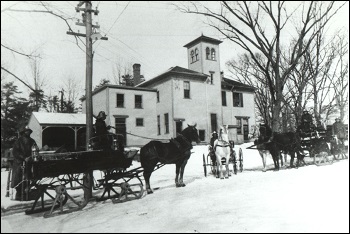 The winter of 1904 produced a large amount of snow and the firemen were concerned that the horses would have to
work too hard pulling the fire apparatus to alarms. One night in January, the men of Company No. 1 transferred
the fire hose from the heavy hose wagon onto a sleigh to be used in the event of a fire. The idea of putting
runners on the hose wagon and the ladder truck during heavy snows was discussed at a meeting a few nights later.
In February 1904 the wheels were removed from the apparatus and "hub runners" were added to the hose wagon and
the ladder truck to allow them to be pulled more easily by the horses through the snow. In December of 1904, in
preparation for another winter, metal rollers were installed at intervals into the apparatus room floor
following the path of the runners. This allowed the hub runners to roll along the floor and out the door rather
than being dragged, making the horses' job a little easier.
The winter of 1904 produced a large amount of snow and the firemen were concerned that the horses would have to
work too hard pulling the fire apparatus to alarms. One night in January, the men of Company No. 1 transferred
the fire hose from the heavy hose wagon onto a sleigh to be used in the event of a fire. The idea of putting
runners on the hose wagon and the ladder truck during heavy snows was discussed at a meeting a few nights later.
In February 1904 the wheels were removed from the apparatus and "hub runners" were added to the hose wagon and
the ladder truck to allow them to be pulled more easily by the horses through the snow. In December of 1904, in
preparation for another winter, metal rollers were installed at intervals into the apparatus room floor
following the path of the runners. This allowed the hub runners to roll along the floor and out the door rather
than being dragged, making the horses' job a little easier.
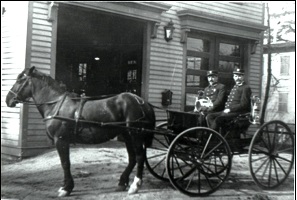 Company No. 1's 1900 hose wagon was a heavy wagon and had been drawn by only one horse. In 1906 while the
Pine Street fire station was undergoing a renovation to allow space for the installation of an improved alarm
system, it was proposed to add another horse to aid in drawing the hose wagon, however the four stalls in the
building were all in use. Two of the stalls were used for the horses to pull the ladder truck, one was used for
the horse to pull the chief's buggy, and the fourth was used for the horse pulling the hose wagon. The alarm
system renovations originally called for a one-story addition, but a new plan was drawn up so that the first
floor area of the addition could be used for a fifth horse stall while a new second floor room in the addition
would be used for the alarm apparatus. A three-horse hitch was added to Company No. 1's ladder truck in 1909,
so the chief's buggy and horse were quartered elsewhere.
Company No. 1's 1900 hose wagon was a heavy wagon and had been drawn by only one horse. In 1906 while the
Pine Street fire station was undergoing a renovation to allow space for the installation of an improved alarm
system, it was proposed to add another horse to aid in drawing the hose wagon, however the four stalls in the
building were all in use. Two of the stalls were used for the horses to pull the ladder truck, one was used for
the horse to pull the chief's buggy, and the fourth was used for the horse pulling the hose wagon. The alarm
system renovations originally called for a one-story addition, but a new plan was drawn up so that the first
floor area of the addition could be used for a fifth horse stall while a new second floor room in the addition
would be used for the alarm apparatus. A three-horse hitch was added to Company No. 1's ladder truck in 1909,
so the chief's buggy and horse were quartered elsewhere.
An article was published in the Hartford Courant in 1907 regarding the availability, or
unavailability, of the horses during the day. In a response to the article, the members of Company No. 1
stated that although the horses used to pull their apparatus were worked by Cheney Brothers during the day,
they assured the public that the horses were always within a minute or two of the hose house as they were almost
always worked around the silk mills. However, the following account appeared in the Hartford Courant the
following year: "No. 1's hose house is but a stones throw from the scene of the fire but it was some time
before they got the first stream working, as the horses which draw the chemical and hose wagon were up on
School Street."
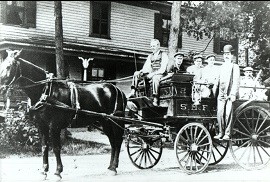 In December 1905, it was voted to purchase horse-drawn hose wagons for Companies No. 2, 3 and 4 at a cost of
$155 each. They were smaller and lighter than the hose wagon owned by Hose & Ladder Company No. 1, which made
it possible to carry more equipment and hose and expedite response times to fires. The new hose wagons for
Companies No. 2, 3 and 4 arrived in January 1906 and immediately took the place of the old hand-drawn hose reels.
A. W. Hollister, who ran the Orford stables, had agreed to supply a horse to Company No. 3 to draw the new hose
wagon to fires, however the hose wagon was heavy and the horse was a light livery horse as opposed to a heavy
farm animal more suited to the work. In July 1906 the company held a drill and the horse was hitched to the
hose wagon and taken out for a ride. Several of the members of the company jumped onto the wagon to go along
for the ride, making a very heavy load. Mr. Hollister discovered this had occurred and strongly objected to the
the horse was subjected to, forcing the company to look for another horse for their hose wagon. They soon
secured an agreement with business owner F. T. Blish for the use of one of his horses.
In December 1905, it was voted to purchase horse-drawn hose wagons for Companies No. 2, 3 and 4 at a cost of
$155 each. They were smaller and lighter than the hose wagon owned by Hose & Ladder Company No. 1, which made
it possible to carry more equipment and hose and expedite response times to fires. The new hose wagons for
Companies No. 2, 3 and 4 arrived in January 1906 and immediately took the place of the old hand-drawn hose reels.
A. W. Hollister, who ran the Orford stables, had agreed to supply a horse to Company No. 3 to draw the new hose
wagon to fires, however the hose wagon was heavy and the horse was a light livery horse as opposed to a heavy
farm animal more suited to the work. In July 1906 the company held a drill and the horse was hitched to the
hose wagon and taken out for a ride. Several of the members of the company jumped onto the wagon to go along
for the ride, making a very heavy load. Mr. Hollister discovered this had occurred and strongly objected to the
the horse was subjected to, forcing the company to look for another horse for their hose wagon. They soon
secured an agreement with business owner F. T. Blish for the use of one of his horses.
Also in 1906, the hand-drawn ladder truck of Company No. 4 was adapted so that it could be pulled by a horse.
At the time with both pieces of their apparatus being horse-drawn, the proximity of the No. 4 hose house to the
Stenberg stable in the rear became a valuable asset, which the company was more than pleased to take advantage
of. Blueprints for a new station for Company No. 4 were received in March, 1906. The plans called for a
two-story building 26 feet by 40 feet constructed of wood and have two double-door bays for apparatus on the
main floor and a second floor with a meeting room and a kitchen. Besides the two double-doors in the front of
the building, there was to be a six-foot wide door in the rear of the equipment room to allow horses to be
brought in from the Stenberg stables adjacent to the station in the rear to pull the fire apparatus. The rear
of the building was just a few feet from the stables and another door was cut through the stable wall to allow
quick and easy access for the horses.
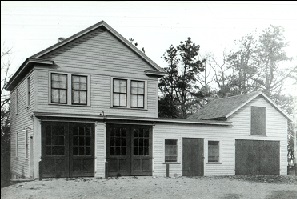 Company No. 2 at the Center built a new station to the rear of Center Congregational Church in 1909. A
stable with room for two horse stalls was connected to the east of the equipment room by a sliding door. The
stalls were each four feet wide with ample room in front and were furnished with running water. A door at the
east end of the stable lead to a wagon shed with hay storage above. It was the plan of the fire district officers
to attract some citizen to allow the firemen to use his/her horses to pull the hose wagon to fires in exchange
for the boarding of the horses in the stable and the use of the wagon shed for their wagon. Most serious fires
occur at night when the horses would in all probability be in their stalls at the hose house. There were no
takers for the proposed deal, however, and Company No. 2 finally reached an agreement with the town to board two
of the town horses at the station at night, but during the day they were out working and were not available.
Company No. 2 at the Center built a new station to the rear of Center Congregational Church in 1909. A
stable with room for two horse stalls was connected to the east of the equipment room by a sliding door. The
stalls were each four feet wide with ample room in front and were furnished with running water. A door at the
east end of the stable lead to a wagon shed with hay storage above. It was the plan of the fire district officers
to attract some citizen to allow the firemen to use his/her horses to pull the hose wagon to fires in exchange
for the boarding of the horses in the stable and the use of the wagon shed for their wagon. Most serious fires
occur at night when the horses would in all probability be in their stalls at the hose house. There were no
takers for the proposed deal, however, and Company No. 2 finally reached an agreement with the town to board two
of the town horses at the station at night, but during the day they were out working and were not available.
On the morning of September 15, 1910, this point was driven home. Mr. E. L. G. Hohenthal was in the
vicinity of the Center when the fire alarm began sounding. Although he was not an active member of the fire
department, he immediately went to the hose house of Company No. 2 to assist and discovered that the town horses
which should be used to draw the apparatus were not available. While Louis R. Barker was getting the doors to
the hose house open, Mr. Hohenthal went about unhitching the horse from his own wagon. Before many of the
firemen arrived, he had hitched his horse to the hose cart and was on his way to the alarm, he himself doing the
driving. Citizens of town readily recognized the Prohibition Party's candidate for Governor of Connecticut
seated on the hose wagon and they cheered along the route as he drove the wagon to the alarm. The following day
his campaign buttons were reportedly very much in demand.
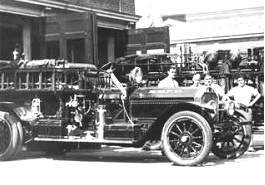 Procuring horses to pull the fire apparatus was becoming increasingly difficult and between 1910 and 1913
South Manchester fire companies began purchasing motorized fire apparatus. A fire on West Center Street in 1913
was the first fire to which all South Manchester's fire companies motorized apparatus responded with the
exception of Company No. 4. They were the only company at the time which still relied on horses to transport
their apparatus to fires. At the annual meeting of the South Manchester Fire District in August, 1913, Company
No. 4 received an appropriation of $6,000 to purchase a modern piece of equipment. At first, Company No. 4 was
interested in purchasing a 'steamer'. It was discovered, however, that the water mains in the area of Main
Street, Company No. 4's primary area for fire protection, were not of sufficient size to supply a steamer. The
'steamer' idea was abandoned and a committee was appointed to look into the purchase of a motorized piece of
pumping apparatus for Company No. 4. The new piece of apparatus was delivered in June, 1914 and became the first
piece of pumping apparatus in the South Manchester department. The delivery of this piece of apparatus spelled
the end of the horse-drawn era for the South Manchester Fire Department and began the era of motorized pumping
apparatus.
Procuring horses to pull the fire apparatus was becoming increasingly difficult and between 1910 and 1913
South Manchester fire companies began purchasing motorized fire apparatus. A fire on West Center Street in 1913
was the first fire to which all South Manchester's fire companies motorized apparatus responded with the
exception of Company No. 4. They were the only company at the time which still relied on horses to transport
their apparatus to fires. At the annual meeting of the South Manchester Fire District in August, 1913, Company
No. 4 received an appropriation of $6,000 to purchase a modern piece of equipment. At first, Company No. 4 was
interested in purchasing a 'steamer'. It was discovered, however, that the water mains in the area of Main
Street, Company No. 4's primary area for fire protection, were not of sufficient size to supply a steamer. The
'steamer' idea was abandoned and a committee was appointed to look into the purchase of a motorized piece of
pumping apparatus for Company No. 4. The new piece of apparatus was delivered in June, 1914 and became the first
piece of pumping apparatus in the South Manchester department. The delivery of this piece of apparatus spelled
the end of the horse-drawn era for the South Manchester Fire Department and began the era of motorized pumping
apparatus.